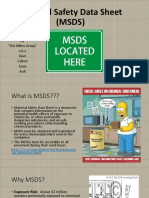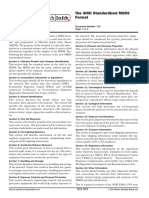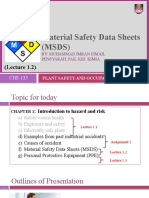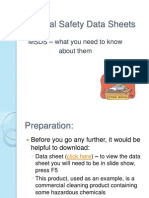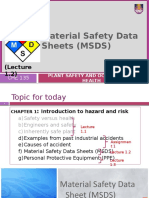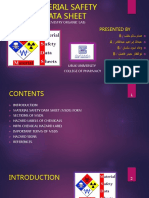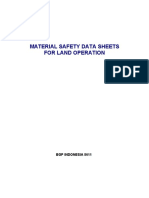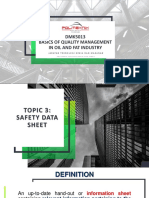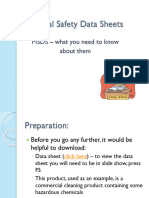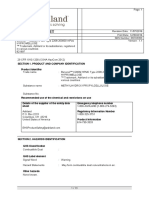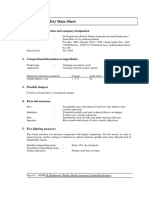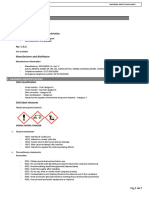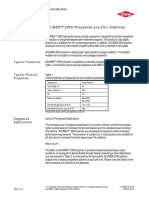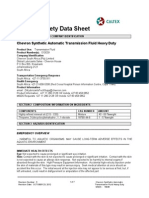WHAT IS AN MSDS
A Material Safety Data Sheet (MSDS) is a document that
contains-
• Information on the potential health effects of exposure
to chemicals
• Safe working procedures when handling chemical
products
MSDSs-
• Are to be provided by Supplier's with all deliveries
• MUST be Accessible to EVERYONE in the workplace
• Must be current
• Must be made available to attending physician in the
event of exposure
SOME DEFINITIONS
• Flash point: Lowest temperature at which
vapors of a volatile material will ignite, given
an ignition source.
• Auto ignition temperature: Lowest
temperature at which it spontaneously ignites in
normal atmosphere without an external source
of ignition.
READING THE MSDS
SOME DEFINITIONS CONT'D
• TWA: An 8-hour Time-Weighted Average is the MSDS Information: Section I PRODUCT
concentration the average worker can be exposed IDENTIFICATION
during an 8-hour workday, day after day, without • Product name and any other common names or
harmful effects. synonyms by which the substance is known.
• Name, address, phone number of the manufacturer,
• Lethal Dose50 (LD50): The value of LD50 for importer, or other
a substance is the dose required to kill half the responsible party, and emergeney phone number.
members of a tested population. • Recommended use of the chemical and any restrictions
on use.
SOME ABBREVIATIONS
1. OEL - Occupational Exposure Limit (g/m*) MSDS Information: Section II HAZARD
2. PEL - Permissible Exposure Limit IDENTIFICATION
3. TLV - Threshold Limit Value • The hazard classification of the chemical (e.g.
4. STEL - Short Term Exposure Limit "Flammable liquid, category I")
5. CAS - Chemical Abstracts Service • Signal word (e.g. "Danger" and "Warning." )
6. OHSA - Occupational Health & Safety Administration • Hazard statement(s) (e.g. "H300: Fatal if swallowed")
7. WHMIS - Workplace Hazardous Material Information • Pictograms
System • Precautionary statement(s) (P102 Keep out of reach of
children)
SOME PICTOGRAMS & SIGNS
MSDS Information: Section III
COMPOSITION/INFORMATION INGREDIENTES
Substances
• Chemical name, common name and synonyms.
• Chemical Abstracts Service (CAS) number.
Mixtures
• Same information required for substances.
• The chemical name and concentration
(i.e., exact percentage) of all ingredients which are
classified as health hazards
�MSDS Information: Section IV FIRST-AID MEASURES MSDS Information: Section IX PHYSICALAND
• Necessary first-aid instructions by relevant routes of CHEMICAL PROPERTIES
exposure (inhalation, skin This section identifies physical and chemical properties
and eye contact, and ingestion). associated with the substance or mixture.
• Description of the most important symptoms or effects, • Appearance
and any symptoms that are acute or delayed. • Odor
• Recommendations for immediate medical care and • Vapor pressure
special treatment needed, when necessary. • Vapor density
• pH
MSDS Information: Section V FIRE-FIGHTING • Melting/freezing point
MEASURES • Solubility
• Recommendations of suitable extinguishing equipment, • Flash point
and information about extinguishing equipment that is not • Auto-ignition temperature
appropriate for a particular situation. • Evaporation
• Advice on specific hazards that develop from the • Decomposition
chemical during the fire, such as any hazardous products temperature
created when the chemical burns. • Flammability
• Recommendations on special protective equipment or • Viscosity.
precautions + for freighters.
MSDS Information: Section X STABILITY AND
MSDS Information: Section VI ACCIDENTAL RELEASE REACTIVITY
MEASURES
• Use of and protective equipment to prevent the Reactivity
contamination of skin, eyes, and clothing during cleanup. • Description of the specific test data for the chemicals).
• Emergency procedures, including instructions for This data can be for a class or family of the chemical if
evacuations, consulting experts when needed, and such data adequately represent the anticipated hazard of
appropriate protective clothing. the chemical(s), where available.
• Methods and materials used for containment (e.g.,
covering the drains) Chemical stability
• Cleanup procedures. • Indication of whether the chemical is stable or unstable
under normal ambient
MSDS Information: Section VII HANDLING AND temperature and conditions while in storage and being
STORAGE handled.
• Precautions for safe handling, including
recommendations for handling incompatible chemicals, MSDS Information: Section XI TOXICOLOGICAL
minimizing the release of the chemical into the INFORMATION
environment, and providing advice on general hygiene • Description of the delayed, immediate, or chronic effects
practices. from short- and long- term exposure.
• Recommendations on the conditions for safe storage, • The numerical measures of toxicity (e.g., acute toxicity
including any incompatibilities. Provide advice on specific estimates such as the LD50)
storage requirements (e.g., ventilation requirements). • Description of the symptoms. This description includes
the symptoms associated with exposure to the chemical
MSDS Information: Section VIII EXPOSURE including symptoms from the lowest to the most severe
CONTROLS/PERSONAL PROTECTION exposure.
• PEL, TV, OEL, STEL and any other exposure limit used or
recommended by the chemical manufacturer, importer. MSDS Information: Section XII ECOLOGICAL
• Appropriate engineering controls (e.g., use local exhaust
INFORMATION
ventilation, or use only
• Impact on aquatic or terrestrial organisms.
inan enclosed system)
• Whether there is a potential for the chemical to persist
• Recommendations for personal protective measures to
and degrade in the
prevent exposure to chemicals.
environment.
• Any special requirements for PPE, protective clothing or
• The potential for a substance to move from the soil to the
respirators (e.g., type of glove material)
groundwater.
• Other adverse effects (e.g. ozone layer depletion, global
warming)
�MSDS Information: Section XIII DISPOSAL
CONSIDERATIONS
• Description of appropriate disposal containers to use.
• Recommendations of appropriate disposal methods to
employ.
• Description of the physical and chemical properties that
may affect disposal activities.
• Any special precautions for landfills activities.
MSDS Information: Section XIV TRANSPORT
INFORMATION
This section provides guidance on classification
information for shipping and transporting of hazardous
chemical by road, air, rail, or sea.
• Transport hazard classes.
• Environmental hazards.
• Guidance on transport in bulk amount.
MSDS Information: Section XV REGULATORY
INFORMATION
This section identifies the safety, health, and environmental
regulations specific for the product that is not indicated
anywhere else on the SDS. The information may include:
• Any national or regional regulatory information of the
chemical or mixtures (including any OSHA, Department of
Transportation, Environmental Protection Agency)
MSDS Information: Section XVI OTHER INFORMATION
• This section indicates when the SDS was prepared or
when the last known
revision was made i
• The SDS may also state where the changes have been
made to the previous version.
• Other useful information also may be included here.
PLEASE REMEMBER!
• MSDS's are NOT Risk Assessments!
• When using substances you must carry out a risk
assessment but use the information in MDSD's to help
you.
• Controls should be proportional to risk!
• Not all MSDS's contain complete information, although
they should have!
• If in doubt, always use Google to consult an expert.

